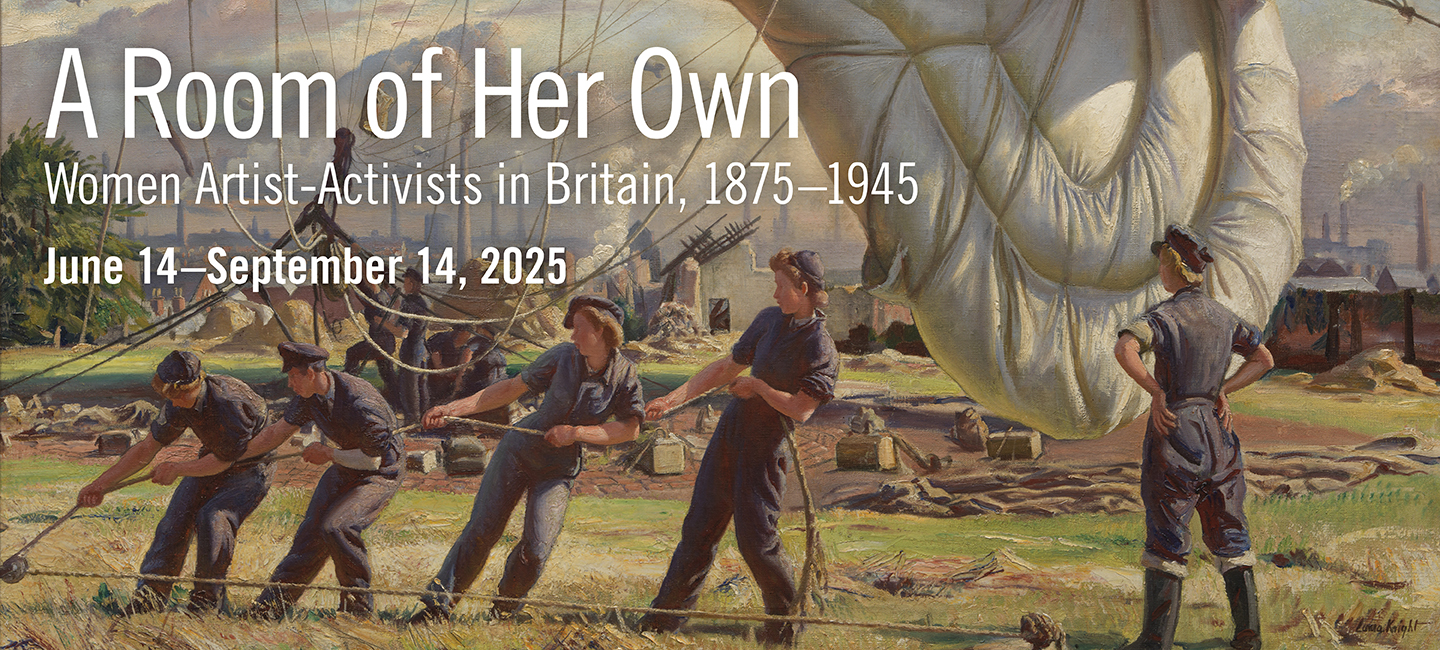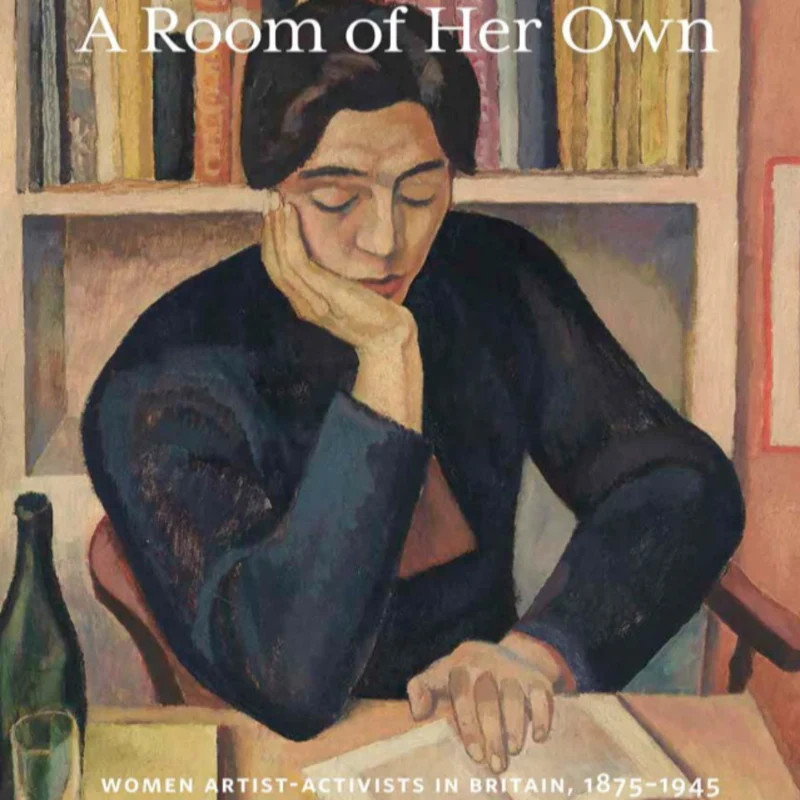About the Artists
A selection of brief biographies and portraits of some of the artists represented in the exhibition
 Anna Airy in her studio, c. 1915, photograph. Private collection
Anna Airy in her studio, c. 1915, photograph. Private collectionThe work of Anna Airy encompasses a wide range of subjects and exemplifies the continuing realist tradition in British art during the first half of the twentieth century. Born in London, Airy studied at the Slade School of Fine Art from 1899 to 1903. Extraordinarily gifted and prolific, she was appointed Britain’s first official female war artist in 1918. Rural subjects became more prominent in Airy’s work following the First World War and especially after 1933, when she moved permanently to the East Anglian village of Playford. Despite the village’s relative isolation, Airy continued to exhibit both nationally and internationally and achieved commercial success.
Born in Belgium to Marie-Pauline Gressin Dumoulin de Boisgirard and the Dutch painter Sir Lawrence Alma-Tadema, Anna Alma-Tadema moved to London as a young child. She learned to paint from her father and stepmother, Laura Alma-Tadema (née Epps), excelling in watercolor before working with oil paint. Her subjects included lavish home interiors, portraits of friends and relations, and rural landscapes. Exhibition records and sale catalogues suggest that Alma-Tadema executed nearly sixty finished works before abandoning her painting career for unknown reasons. Of these works some twenty are known today, including the Clark’s The Garden Studio.
 Anna Alma–Tadema, Self-Portrait, c.1886-93, oil on panel. Ömer Koç Collection
Anna Alma–Tadema, Self-Portrait, c.1886-93, oil on panel. Ömer Koç Collection Vanessa Bell, Self-Portrait, c. 1915, oil on canvas laid on panel. Yale Center for British Art, New Haven, Connecticut, Paul Mellon Fund, B1982.16.2
Vanessa Bell, Self-Portrait, c. 1915, oil on canvas laid on panel. Yale Center for British Art, New Haven, Connecticut, Paul Mellon Fund, B1982.16.2A founding member of the Bloomsbury Group whose younger sister was the novelist and essayist Virginia Woolf, Vanessa Bell (née Stephen) was a painter and designer who deftly gathered avant-garde artists, writers, and critics together in her London and country homes. She organized art clubs and developed exhibition opportunities for artists who embraced modernism, becoming a leading early twentieth-century proponent of new artistic expression that privileged form and color over narrative content.
Born Mary Evelyn Pickering, Evelyn De Morgan’s art education at the Slade School of Fine Art was hard-won; her artistic ambitions were impeded by family resistance. Possessed by a lifelong love of Italian Renaissance art, De Morgan created paintings and drawings saturated with color and rich in detail. Her work dealt with an array of spiritualist, neoclassical, and religious themes, including Greek myths and Christian subjects. She exhibited prolifically throughout her life, including the paintings The Field of the Slain and The Red Cross.
 Evelyn De Morgan, c. 1900, photograph. De Morgan Collection, Barnsley, United Kingdom, PH0031
Evelyn De Morgan, c. 1900, photograph. De Morgan Collection, Barnsley, United Kingdom, PH0031 Gluck, Medallion (You/We), 1936, oil on canvas. Ömer Koç Collection
Gluck, Medallion (You/We), 1936, oil on canvas. Ömer Koç CollectionFrom a young age the painter Gluck went by a single name, rejecting the birth name Hannah Gluckstein. In appearance, Gluck was also distinctive, flaunting gender norms by wearing cropped hair and tailored men’s clothes and smoking a pipe. The artist’s early oeuvre includes insightful portraits, anthropomorphic flower paintings, serene landscapes, and theater genre scenes. After a middle period spent lobbying successfully for consistent standards in artist materials, in the 1970s Gluck triumphantly returned to painting and the public eye with one of the artist’s most significant works, Credo: Rage, Rage, Against the Dying of the Light (1970/73, private collection), inspired by a dead fish on a beach.
Dame Laura Knight (née Johnson) was one of the most successful and popular painters of her era. A modern figurative painter, she became particularly celebrated for her Cornish landscapes, paintings of the London theater world, and the work she produced as an official war artist. During Knight’s lifetime, her work was included in most major British and many international group shows, as well as numerous solo exhibitions. Significantly, in 1936 Knight was elected a Royal Academician. Until then, no woman had been elected a full member of Britain’s most prestigious exhibiting society since its two female founding members in 1768.
 Bassano, Laura Knight, 1936, photograph. National Portrait Gallery, London, given by Bassano & Vandyk Studios, 1974. NPG x 19414
Bassano, Laura Knight, 1936, photograph. National Portrait Gallery, London, given by Bassano & Vandyk Studios, 1974. NPG x 19414 Arthur James Langton, Mary Lowndes, c. 1890s. platinum print. National Portrait Gallery, London, given by Ann O’Donoghue, 2011, NPG P1688
Arthur James Langton, Mary Lowndes, c. 1890s. platinum print. National Portrait Gallery, London, given by Ann O’Donoghue, 2011, NPG P1688While she primarily trained in painting, Mary Lowndes produced her first work in stained glass in 1885. She went on to create over 100 pieces in that medium. Lowndes partnered with Alfred Drury in 1897 to found an eponymous studio that offered a new generation of glass artists working space and technical assistance. Lowndes also played a key role in the fight for women’s suffrage. She joined the National Union of Women’s Suffrage Societies (NUWSS) after the International Congress of Women of 1899 and was passionate about the cause. In 1907 Lowndes cofounded the Artists’ Suffrage League, which designed postcards, posters, and banners to sell in support of the NUWSS.
May Morris grew up in an art-loving, socially progressive household; her father was the designer, author, and noted socialist thinker William Morris and her mother, Jane Burden Morris, was an accomplished embroiderer who modeled for Pre-Raphaelite artists. In her own richly creative life, Morris worked as a designer, embroiderer, jewelry maker, teacher, lecturer, editor, and writer. Today her distinctive achievements in art and craft, literature, education, politics, and cultural preservation are increasingly celebrated in books and exhibitions devoted to her aesthetic sensibility, technical skill, and sheer determination to accomplish the work set before her.

